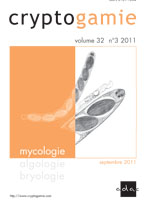Tremella fuciformis, a typical dimorphic fungus, displays two distinct morphological transitions: (i) yeast-pseudohyphae transition; (ii) yeast-hyphae transition. To understand the mechanism of its dimorphism, we initiated a study by investigating how environmental factors affect the yeast-to-pseudohypha transition, including pH value, temperature, carbon source, nitrogen source, cultural time, ethanol and inoculum size. Our studies showed that the optimal conditions for yeast-to-pseudohypha transition were as follows: incubating at 25 to 30°C for 3 to 7 days in media containing glucose as the carbon source, ammonium as the nitrogen source and 10 ml/L ethanol. Below a threshold of inoculum size (105 cells/L), the transition ratio fluctuated markedly, which made us propose that quorum sensing molecules contribute to the dimorphic behavior in T. fuciformis.
How to translate text using browser tools
1 December 2011
Effects of Environmental Factors on Dimorphic Transition of the Jelly Mushroom Tremella Fuciformis
Lihua Hou,
Yi Chen,
Chengjie Ma,
Juan Liu,
Chen Liguo,
Aimin Ma
ACCESS THE FULL ARTICLE
It is not available for individual sale.
This article is only available to subscribers.
It is not available for individual sale.
It is not available for individual sale.

Cryptogamie, Mycologie
Vol. 32 • No. 4
December 2011
Vol. 32 • No. 4
December 2011
Inoculum size
morphology
Pseudohypha
Tremellales
yeast




